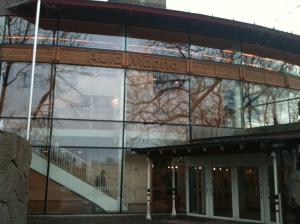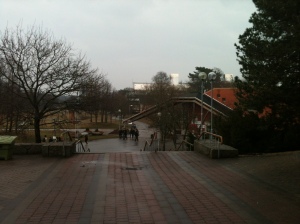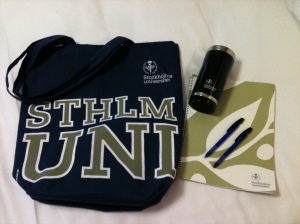Sorry for the delay with the last installment, it was a very busy weekend of sightseeing in Stockholm and then I haven’t had the chance to write since I’ve been back. Until now (got to love a bank holiday!)
My last day at the University of Stockholm started pleasantly with fika. This is a weekly tradition, in which different ‘teams’ take turns to cater each week, usually providing savoury as well as sweet finger food to go with the coffee. This is the same team that is in charge of tidying the communal kitchen and putting the dishwasher on, they take it in turns. As well as being a social gathering, Marie, the Head of HR, will use these meetings in future to deliver key messages and hold discussions on topical issues. I presented the department with the information on Bath Spa I’d brought from the UK, thank you cards and biscuits I’d brought over with me from Fudges bakery in Dorset. They seemed to go down really well!
After fika, we went to the Faculty of Science office to speak to several professional services colleagues about their recruitment process. This is completely decentralised and HR is not involved at all, which was new to me. It has to be really, as the Faculty alone is 6000 students! Focussing on academic staff, they started by talking about Professorial appointments, which are always made from internal candidates by committee. I believe that the Faculty Board makes a recommendation to the Vice-Chancellor who has the ultimate decision making authority.
In terms of Lecturers and Senior Lecturers, these posts are advertised externally, and usually internationally, in order to attract the best researchers. There is a web based application form which is as expected. However, for both Professorial and Senior Lecturer appointments, external panel members are sought to look at each application and rank them according to research quality. They have to provide a report on their findings. The external panel members are paid a fixed fee of £3000 plus expenses, and all costs are borne by the Faculty. The panel also consists of an appointment board of 4, including a student representative, who are elected on a rotating basis. They meet to decide the shortlisting and then to carry out interviews. The external panel members can do the shortlisting remotely but have to attend in person for the interviews. The Dean has the final say in terms of hiring senior lecturers.
Two things struck me about the recruitment process. The first was the time it takes, usually 6-8 months, but it can be up to a year. Although they do occasionally lose good candidates to other institutions, there is a general understanding that the process takes time. Jobs are often advertised for several months before applications are considered, and it can take 6 weeks for the reports to come back from the referees, for example.
The second thing was the openness and transparency of the whole process. The Swedes pride themselves on this anyway, and it is reflected in the way information is shared with the applicants. All applicants are told how many other applicants there are, what the selection process is and who the panel are. They are also told who got the job. They get to see all documentation as the process develops, all the shortlisting documentation is shared along with the reports on research quality, so they can see who else has applied and how the decision to shortlist or appoint was reached. They can appeal decisions within three weeks, but they only get a few appeals a year as the process is so transparent. This is amazing but means managers have to be so careful about what they write as it is all disclosed. This happens in the UK as well but only if a claim is made, so people really think about the assumptions and judgements they are making, ensuring everything is evidence based, which is a really positive step in recruitment and selection.
Because the University is research-led, all applicants have to attach their PhD certificate, and list 10 publications, but if they don’t have a teaching qualification they have to do a certain number of credits on the certificate within the first two years, which was encouraging. Teaching is also assessed at interview with public lectures which the panel attend but anyone else can too (apart from the other candidates, of course!) They do a certain amount of targeting of desirable candidates and create a wish list before advertising, which has to include women. These people are then sent the advert and invited to apply.
In terms of negotiating the salary, there is a range they work within, but most people want to expand their research, and are most interested in facilities, equipment, infrastructure and PhD students. These are often very generously funded by the Faculty, because of course, the research will ultimately benefit the University. I was surprised that not a great deal of support is offered to overseas nationals coming to work in Sweden for the first time. This is something they are looking to improve, as they have lost people when, for example, they couldn’t offer help with finding schools for the successful candidate’s children. This is a risk which could be easily averted with a little investment of resource and is something we need to consider too as the little things make a big difference to someone relocating.
Next I was off to the Marketing department to meet the University’s brand manager, Helena, and internal communications officer, Marie. Like us they have done a lot of work to define what makes the University distinctive, including celebrating its long and illustrious history. The offer is very clear and is centred on a University which is integrated with the city, with a particular focus on natural science. The campus is set in a national park which helps! Helena gave me a beautiful poster which includes original artwork used across the University’s website and printed collateral which tells its story. For example, the first female Professor in the world was at Stockholm University in the 19th century, she was Professor of Maths. There are some older buildings on the campus which used to be private houses, but the University moved from the city centre in 1972, so many buildings are from that era. The University rents all of its estate from the government and doesn’t actually own any property.
We also talked about internal communications. I had been interested to find out that there were communications officers in the Faculties and departments, again, structured using a very decentralised model. There are 250 of them, and Helena explained that the role of the Marketing department is to try to align the information they receive and distribute, offer training and support in coming up with departmental communication plans.The Marketing department has responsibility for gathering the key messages on a regular basis, usually from senior management meetings, and from people feeding information through to them. They then distribute the key messages to the communications officers who work with the Heads of departments to ensure they are cascaded and then feedback is fed upwards.
The website is also a main source of information for staff, and has been much improved over the last few years with a clearer structure, editing rights and navigation. Like Bath Spa, they have increased the use of social media as a communication tool and the VC does a regular blog (in English) and video blog (in Swedish). There is also a termly magazine which includes key highlights translated into English for international staff.
I was surprised that open days are not organised centrally, but by departments. This means that they don’t always have the correct information or give a consistent message to prospective students.
Another initiative Marketing are involved with at the moment is a storytelling project. They have run workshops which involve employees telling their stories of what the University means to them, what their work involves and other interesting things. These are then collated and shared as part of the overall narrative of the University.
My final session of the week was with the Head of HR, Marie. We didn’t have long together, but after talking about the structure of our department, I talked her through the people strategy which she was really interested in. I also told her about the CIPD, and showed her the profession map on the website, as we had talked about our strategic area of HR capability and how we are developing as an HR team to deliver the strategy. They don’t have a professional body in Sweden which I was really surprised about, and it may be that the CIPD could do well there, as I know they are aiming to promote their professional standards and services to the HR profession more globally.
Well, the formal sessions were over. What a fantastic week! I was very touched to be invited for a drink with Nina, and it was a great opportunity to talk about the week and also about our plans for the short and long term. We promised to keep in touch and I’ve challenged her to get a Twitter account so we can follow each other. I was really pleased that Marie from Marketing was impressed with my use of social media 🙂 I have learnt so much and have so many ideas to explore further and take forward. Thanks to everyone for their welcome, time and efforts this week. I would recommend the Erasmus experience to anyone!







